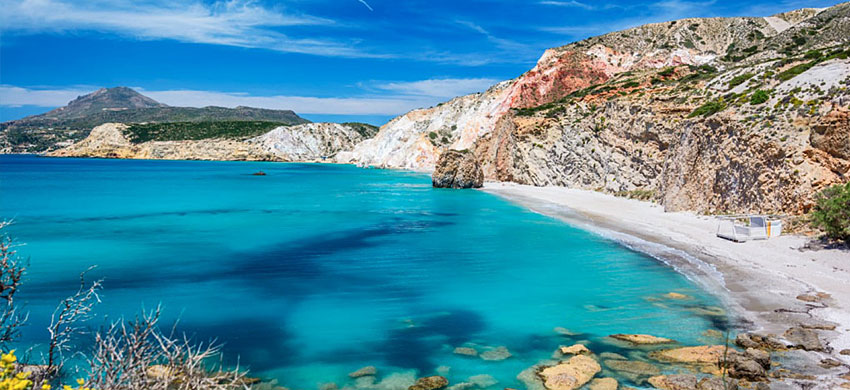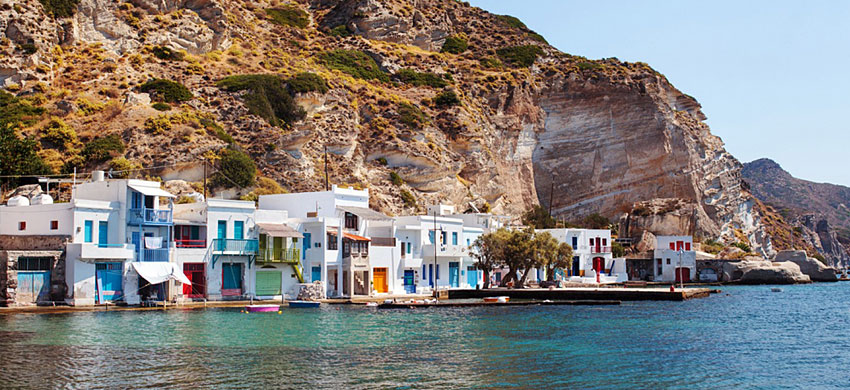

Beauty is the distinctive feature of the island of Milos, whose name immediately brings to mind the famous Greek sculpture of the Venus of Milos, the symbol of classical female beauty, which was found here in the 19th century.
During a vacation on the island you will not be able to see the Venus de Milo, which is jealously guarded at the Louvre in Paris, but you will find beauty in abundance, including picturesque villages, enchanting beaches bathed by a blue sea, remains of ancient civilizations and if you are lucky even one of the monk seals that swim in the waters of the island.
This volcanic island with its curious horseshoe shape is also called the island of colors for its rock formations with surreal colors and shapes, but beautiful are also the shades of the sea, blue, blue or emerald green, and the white stone characteristic of the island.
If you are still not convinced to leave, we remind you that Milos is the island of the Cyclades with the greatest number and variety of beaches, all of a beauty worthy of Venus!

On the island of Milos there are more than 70 beaches, which if we do the math right means that to see them all you would have to stay here at least a month and visit more than two beaches a day! We’re sure you wouldn’t mind, but maybe your employer would…
In addition to being many, the beaches of Milos are also extremely varied: you can choose between picturesque city beaches, crescents of soft sand, bays bordered by impressive rocky backs of various colors, white rocks on which they create incredible play of light … all bathed by a beautiful sea, with clean and clear waters that invite a refreshing dip.
Since the time of a vacation imposes a choice, we have selected for you the most beautiful beaches of Milos:

Adamas (or Adamantas) is a lively port town that offers numerous tourist services. The choice of accommodation, including hotels, b & bs and vacation homes is very wide, in addition you will find many stores, bars and restaurants.
In the summer evenings the lovely waterfront comes alive with tourists strolling after dinner, but if you want to get an idea of how life was on the island before tourism became the main activity, wake up early and go to see the fishermen returning from the sea selling fresh fish at the port of Adamas.
The enchanting Plaka is a picture-postcard village that perfectly embodies the image we have of villages in the Greek islands.
This labyrinth of narrow streets and white houses perched on the slopes of a hill, with a blue sea in the background, occupies the area where the ancient city of Milos once stood, destroyed by the Athenians and rebuilt by the Romans.
If you want more tranquility choose Pollonia, a fishing village on the northern coast that in summer turns into an elegant tourist resort.
The island of Milos has a long mining tradition that lasts even today, with the European primacy of the extraction of bentonite (a particular type of clay) and perlite.
To this very important activity for the economy of the island is dedicated the small but well-kept Museum of Mineralogy, where you will find lots of information on the geological conformation of Milos and its volcanic origin and where you can trace the history of mining on the island.
Can there be a Greek town without a Museum of Archaeology? Probably not! At the Archaeological Museum of Milos you can admire a faithful reproduction of the Venus of Milos, one of the most famous ancient Greek artifacts in the world, as well as a collection of figurines dating back to the period between 1400 and 1100 BC.
If you have some time left, you can also browse around at the Museum of Folklore and History in Plaka, where a traditional house has been reconstructed with furniture, objects and period clothing, or at the Museum of Sacred Art in Adamas.
The only Christian catacombs in Greece are located on the island of Milos and can be visited with a guided tour: they are perfect for those who want to know the history of early Christianity, but also to find some ‘shelter from the summer heat!
In the surroundings of Pollonia are the remains of the ancient Minoan city of Phylakopi10: there is not much left to see, but the ruins are set in a beautiful natural setting, so it is worth visiting this historic site.
For an extraordinary panoramic view of the island climb to the top of Fortezza di Kastro11, built on the ancient acropolis of Plaka, where there is also a small church of the thirteenth century.
If the Mineralogy Museum has got you hooked or if you are an inveterate walker, you can deepen your knowledge of the natural environment and history of Milos with the fascinating half-day geo-walks proposed by the Miloterranean Geo Project.
Following the detailed maps created as part of the project, you can experience extraordinary treks through villages, breathtaking natural landscapes, mines and historical sites.
In the following map you can see the location of the main places of interest mentioned in this article.
Aboat trip is always the best way to visit an island because it allows you to admire the coastline with its many coves, then consider that some of the most beautiful beaches are accessible only by boat.
All boat trips departing from the port of Adamas include a visit to the cave of Sykia and the famous stacks of Kleftiko, impressive arched rocks that emerge proudly from the sea: the boats will take you through the arches and in many cases there is a stop for a swim.
Milos can also be visited with a day trip from other nearby Cycladic islands, such as Santorini. It is not the ideal solution to appreciate its slow pace of life, but it allows you to see this little corner of paradise on earth.
The main urban settlements of the island of Milos, where hotels and vacation homes are concentrated, are Adamas (also called Adamantas), Plaka and Pollonia (or Apollonia). Smaller are the villages of Klima, Mandrakia and Fourkovounni, which however are very characteristic and worth a visit.
Although the offer of accommodation has increased in recent years, do not expect to find tourist supercomplexes and megaresorts: better to book in advance your hotel or b&b.
On the island of Milos there is an airport, where daily flights from Athens land.
To reach Milos by sea, you can take a ferry or hydrofoil from the port of Piraeus in Athens: the duration of the crossing varies from 3 to 7 hours, depending on the means chosen and the number of stops made.
You can also take a ferry to Milos from Ios, Sikinos, Folegandros, Santorini, Crete and other islands of the Eastern Cyclades. They don’t run daily services, so it’s advisable to book in advance both the outward and the return, checking well the days and times of departure.
The Venus de Milo (also called Aphrodite of Milos), a marble statue dating back to 130 BC, is unanimously considered one of the most beautiful sculptures of antiquity, embodying the ideal of female perfection in classicism.
Its fame has made the name of the island of Milos known throughout the world: it was found in 1820 by a farmer of the town of Plaka while he was digging his own field, seized by the Turkish authorities and later purchased by the French ambassador, who brought it to Paris where it is still located.
Lacking a base and arms, the statue is 202 cm high. It is attributed to the Hellenistic sculptor Alexander of Antioch.
What's the weather at Milos? Below are the temperatures and the weather forecast at Milos for the next few days.